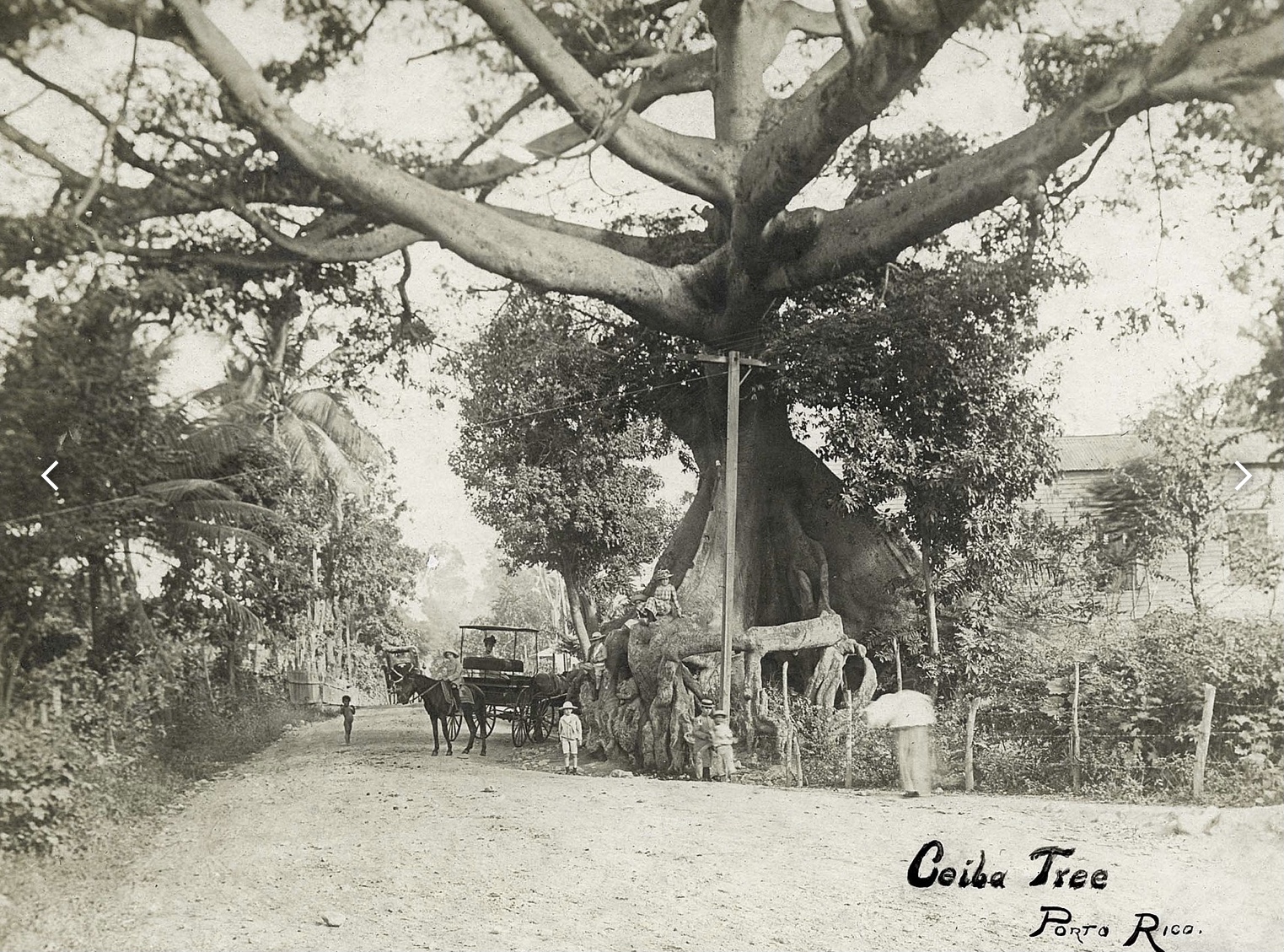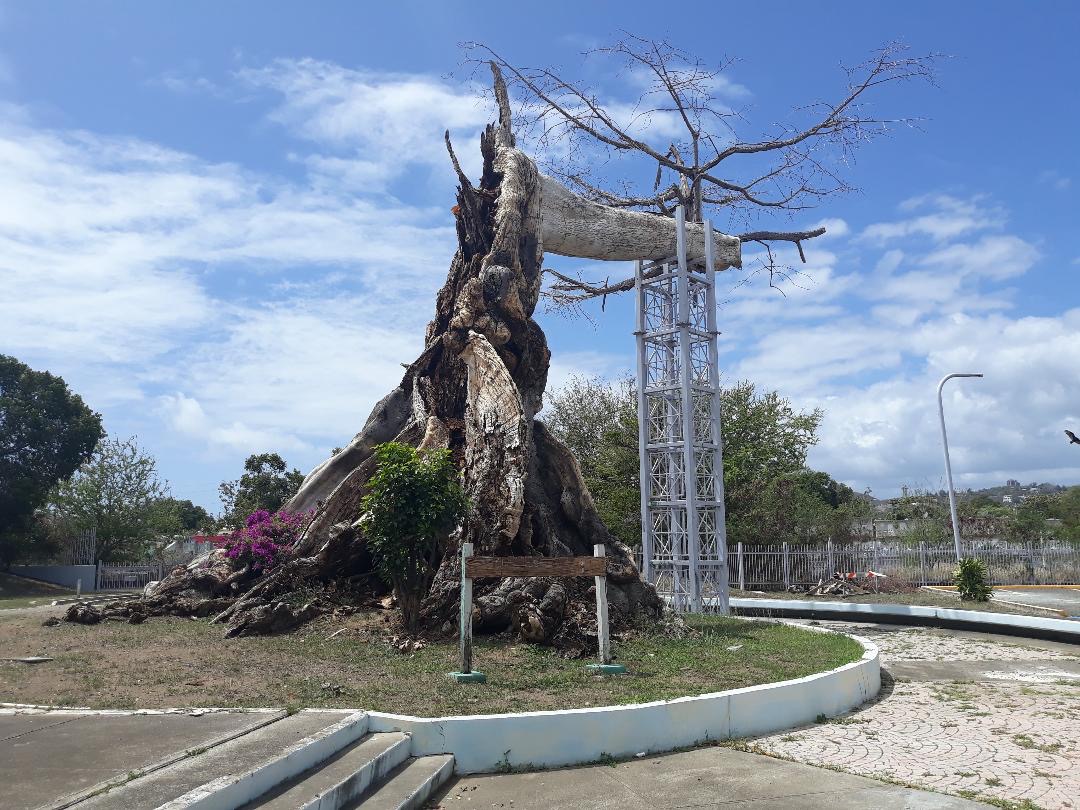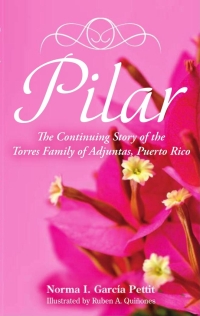Ponce’s Famous Ceiba Tree
In Ponce’s barrio San Antón, there is a park called El Parque de la Ceiba, which opened in 1984.
In the center of this small park there was—surprise! – a ceiba tree of significant historic importance. It is
believed to have already been a large tree at the time of the arrival of Christopher Columbus in 1493. In
the areas surrounding this tree, broken indigenous pottery, shells, stones and other evidence of the
presence of Taíno Indians have been found. In fact, the name ceiba comes from a Taíno word. Legend
says that underneath the massive tree's canopy, the Taínos celebrated their religious rites. It is also
believed that the first European settlement in the Ponce region was right in that very area, next to the
Río Portugués. Later, slaves purportedly danced under that tree when the harvest seasons ended.

In the above picture of the ceiba taken in 1900, it measured close to 118 feet in circumference. I
am not sure of how tall this tree was in its heyday, but ceiba trees can grow up to 180 feet tall. The
buttresses, or exposed roots, of the Ponce ceiba were well over six feet high.
I speak of this tree in past tense because this tree, sadly, is dead.
It suffered through countless hurricanes, but the final blow to this iconic symbol was caused by
the channelization of the Río Portugués which began in 1974 and was completed in 1997. Intended to
prevent flooding of adjacent communities, the redirecting of the river deprived the ceiba tree of the
water that it needed for survival. In December of 2006 it lost a large limb and in July of 2011 it lost
another large limb, leaving only 35% of the tree alive. In the subsequent decade, the tree continued to
deteriorate. I took the picture below on our trip to Puerto Rico in the spring of 2022.


One man, revered Ponce artist Luis “Tato” González, created a work of art to memorialize the
trunk of this once giant tree. Titled, “El Sudario de la Ceiba,” this enormous piece of art is the largest in
the world using a technique called frottage. The canvas, completed a year ago, measures 40’ x 40’. I am
including a link to a video about this amazing project.
https://www.youtube.com/watch?v=U5WAW_Y8x4k
In the video, Tato is the man in the red shirt, while the man in the white shirt (wearing a face
mask) is my cousin, René Rivera Sevilla, an artist in his own right and a friend of Tato’s. Randy and I have
been blessed to meet Tato González in person and to share a meal with him on a couple of occasions.
I have attempted to memorialize the Ponce Ceiba tree in my own way. It is talked about (and
visited) by the characters in my second book, which will be published soon. The sequel to Luisa is about
her brother, Sebastián, who moves to Ponce in September of 1870. Our trip to El Parque de la Ceiba
was part of my research for this new book. I wanted to see the tree before it decayed completely. In its
present state it is hard to believe how majestic this tree once was, but in the pages of my book I hope I
can transport readers back in time to appreciate the beauty of Ponce’s historic ceiba tree.
In the center of this small park there was—surprise! – a ceiba tree of significant historic importance. It is
believed to have already been a large tree at the time of the arrival of Christopher Columbus in 1493. In
the areas surrounding this tree, broken indigenous pottery, shells, stones and other evidence of the
presence of Taíno Indians have been found. In fact, the name ceiba comes from a Taíno word. Legend
says that underneath the massive tree's canopy, the Taínos celebrated their religious rites. It is also
believed that the first European settlement in the Ponce region was right in that very area, next to the
Río Portugués. Later, slaves purportedly danced under that tree when the harvest seasons ended.

In the above picture of the ceiba taken in 1900, it measured close to 118 feet in circumference. I
am not sure of how tall this tree was in its heyday, but ceiba trees can grow up to 180 feet tall. The
buttresses, or exposed roots, of the Ponce ceiba were well over six feet high.
I speak of this tree in past tense because this tree, sadly, is dead.
It suffered through countless hurricanes, but the final blow to this iconic symbol was caused by
the channelization of the Río Portugués which began in 1974 and was completed in 1997. Intended to
prevent flooding of adjacent communities, the redirecting of the river deprived the ceiba tree of the
water that it needed for survival. In December of 2006 it lost a large limb and in July of 2011 it lost
another large limb, leaving only 35% of the tree alive. In the subsequent decade, the tree continued to
deteriorate. I took the picture below on our trip to Puerto Rico in the spring of 2022.

One man, revered Ponce artist Luis “Tato” González, created a work of art to memorialize the
trunk of this once giant tree. Titled, “El Sudario de la Ceiba,” this enormous piece of art is the largest in
the world using a technique called frottage. The canvas, completed a year ago, measures 40’ x 40’. I am
including a link to a video about this amazing project.
https://www.youtube.com/watch?v=U5WAW_Y8x4k
In the video, Tato is the man in the red shirt, while the man in the white shirt (wearing a face
mask) is my cousin, René Rivera Sevilla, an artist in his own right and a friend of Tato’s. Randy and I have
been blessed to meet Tato González in person and to share a meal with him on a couple of occasions.
I have attempted to memorialize the Ponce Ceiba tree in my own way. It is talked about (and
visited) by the characters in my second book, which will be published soon. The sequel to Luisa is about
her brother, Sebastián, who moves to Ponce in September of 1870. Our trip to El Parque de la Ceiba
was part of my research for this new book. I wanted to see the tree before it decayed completely. In its
present state it is hard to believe how majestic this tree once was, but in the pages of my book I hope I
can transport readers back in time to appreciate the beauty of Ponce’s historic ceiba tree.
